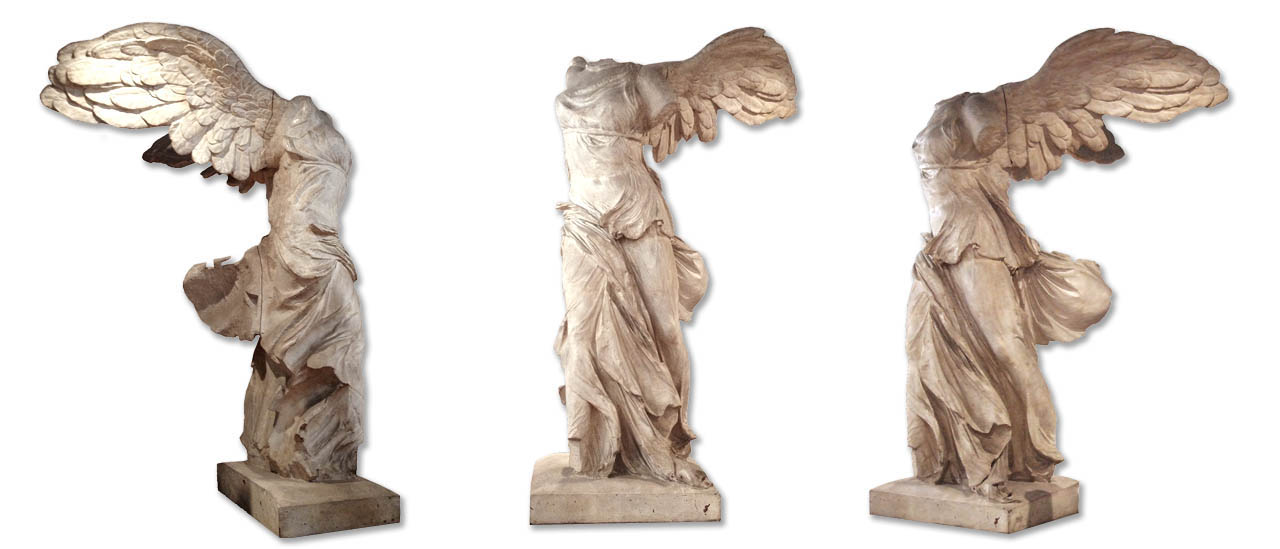While the problems of her date, authorship, and historical context are notorious, the Nike of Samothrace remains one of the most astonishing images of victory ever created. Alighting on the bow of her carved stone ship, waves crashing beneath its prow - an effect probably enhanced by an actual fountain spraying water across her body - the Samothracian Nike embodies everything that we have come to expect from the “baroque style” of sculpture popular during the third and second century B.C.E. in Greece.
The ‘Hellenistic baroque’ was one of most recognizable styles available to sculptors during the third and second centuries B.C.E.. The style’s formal and conceptual characteristics are distinct. From a conceptual point of view, Hellenistic sculptors working in the baroque mode attempted to evoke a dynamic sense of movement, to stir potent feelings of powerful (usually hyperbolic) emotion, and to place the action of their players within powerful theatrical and dramatic narrative frames.
For the baroque sculptor, poetic and rhetorical principles such as auxesis (‘amplification’), dialogia (‘repetition’), megaloprepia (‘grandeur’), deinosis (‘intensity’), ekplexis (‘shock’) and enargeia (‘vividness’) were both aesthetic goals and the means by which these goals were achieved. In short, sculptors in the ‘baroque mode’ were trying to blow the doors off.
In order to accomplish this range of spectacular effects, Hellenistic sculptors working in the baroque mode consistently deployed three well-known and interrelated formal strategies. First, Hellenistic sculptors consistently distorted and amplified baroque anatomies for extravagant impact.
Second, Hellenistic sculptors consistently exaggerate baroque physiognomies to unlock the intense, theatrical depths of pathos. Finally, Hellenistic sculptors consistently alter and embellish baroque draperies and surface textures to create fluctuating impressions of dramatic torsion, extravagant space, grand motion and sharp contrasts.
Always, these three formal characteristics interconnect. Always these formal traits are unified by a pervasive sense of vivid exaggeration and dramatic flux that is generated and reflected both by individual sculpted figures and by the larger sculptural narratives that they constitute. It is with good reason that our most respected scholars of Hellenistic art have suggested that the principal agenda of the sculptors working in the Baroque mode was psychagogia – the swaying of the soul. The Nike of Samothrace sees this style at its apex. Here, the Nike’s sculptor cut his drapery loose from all practical restraint.
On one hand – at her stomach and breasts - Nike’s drapery cradles, clutches, and clings to her powerful and provocative body, both describing and obscuring the sensual flesh beneath.
On the other hand - at her legs and hips – Nike’s drapery seems to have been released from its task of outlining the human figure and is allowed become raw, expressive form in its own right. The energetic, the momentary, the ephemeral - all these traditional aspects of Nike’s mythical persona are captured here.
The subtle, light incisions that run over her drapery further this effect. The small, concentric furls of drapery that sweep over her proper left hip and then rise away from her body proper at her pubis have almost nothing to do with the rational fall of wind-swept cloth but everything to do with a baroque illusion of force and dynamism, torsion and energy: the literal and metaphorical embodiment of victory in stone.
The statue was, perhaps, commissioned by the Hellenistic king Demetrios Poliorketes in the early third century B.C.E. to commemorate victories in the eastern Mediterranean; although it might have commissioned in the middle third century to celebrate the Battle of Kos won by Antigonos Gonatas. Either way, there can be little doubt that the Nike of Samothrace stands as one of the most important representations of victory ever made.
NIKE OF SAMOTHRACE
Contacts
John Goodinson Artist/designer/illustrator
Christina Jansen Photographer
Phenomenists Internet Agency/ISP
The British Museum London England
The Acropolis Museum Athens Greece
Maxon Software Developer
Our affiliate partner
Theran Press is the academic publishing imprint of Silver Goat Media. Theran is dedicated to authentic partnerships with its academic associates, to the high quality design of scholarly books, and to elite standards of peer review. Theran seeks to liberate intellectuals from the confines of traditional academic publishing. Theran authors are authorities and revolutionaries in their respective fields.
Theran encourages new models for generating and distributing art, science, and knowledge. For our creatives. For our communities. For our world.
Our Hosting Partner
Phenomenists Internet (ISP) was founded in 2000, to meet a growing demand for cost-effective and
reactive internet services, Phenomenists have provided the hosting services and support for all our online projects since 2008. John Goodinson is a member of the creative team and has worked with Phenomenists since 2008.
